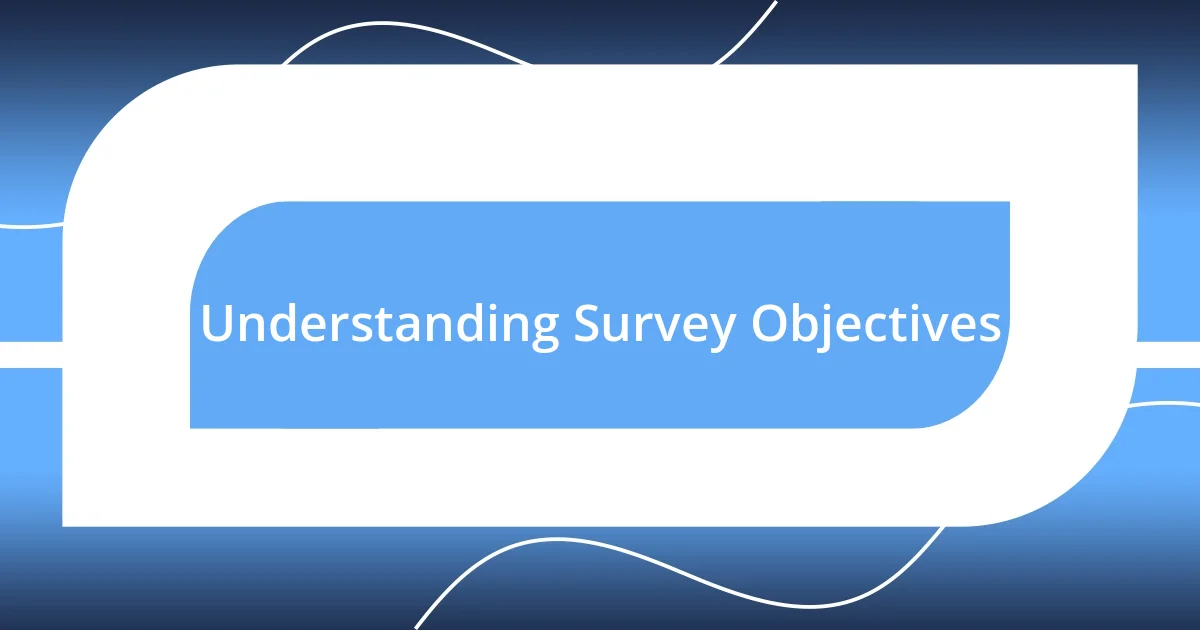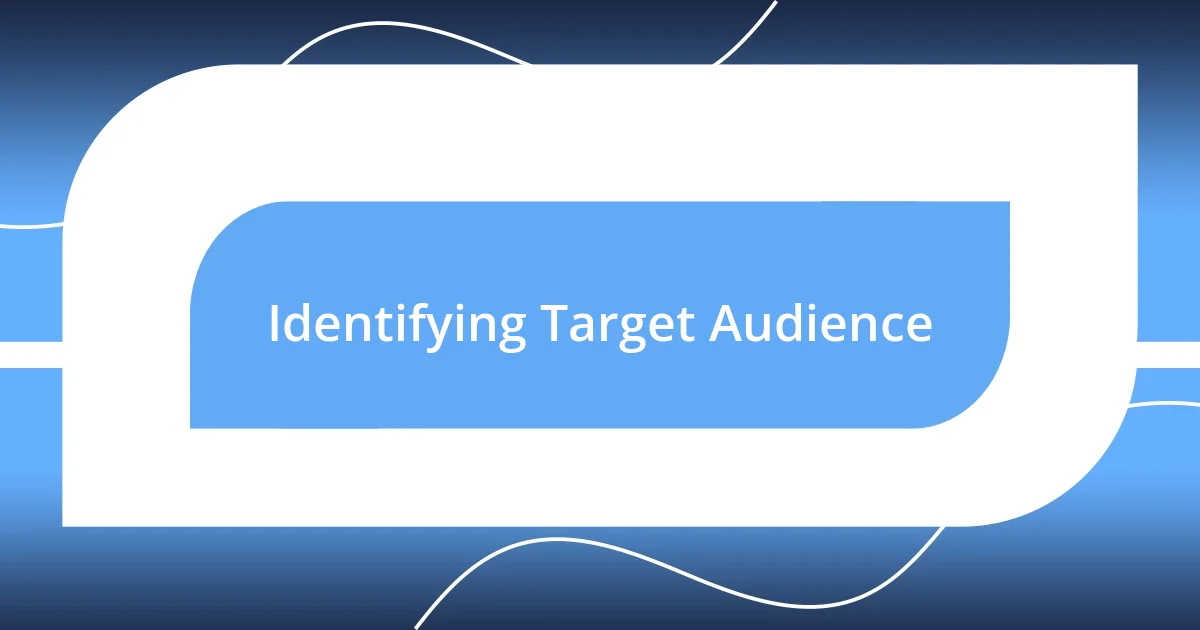Key takeaways:
- Clearly define survey objectives to shape your questions and gather meaningful insights.
- Identify and segment your target audience to tailor questions, enhancing engagement and data quality.
- Analyze results thoughtfully, focusing on both quantitative metrics and qualitative insights to drive actionable improvements.

Understanding Survey Objectives
Understanding the objectives of your survey is like setting the compass before embarking on a journey. I remember a time when I launched a survey on customer satisfaction, unsure of what specific outcomes I wanted. It was only after honing in on my objectives that I identified key areas for improvement, ultimately leading to actionable insights.
When I think about how survey objectives shape the entire process, I can’t help but ask: What do I genuinely want to learn? This question has guided me through many projects. For example, a recent survey aimed to explore employee engagement levels. By clearly stating that my goal was to understand employee feelings, rather than just gathering data, I was able to craft more meaningful questions that really resonated with respondents.
Moreover, having well-defined objectives allows you to frame your questions effectively. It’s like knowing the destination before planning the route; every question becomes a step toward an informed conclusion. I’ve learned that vague objectives often lead to confusing data. By understanding exactly what I want to measure, I’ve been able to collect feedback that truly adds value to my projects.

Identifying Target Audience
When it comes to identifying your target audience, I find it essential to think critically about who will benefit from your survey. In my experience, I often create a detailed profile of my ideal respondents. For instance, when I wanted to gather insights on a new product, I pinpointed specific demographics, such as age, location, and buying behavior. This process clarified my focus, allowing relevant voices to be heard.
Another approach involves segmenting your audience based on their previous interactions with your brand or product. For one survey I conducted, I divided respondents into categories like first-time buyers versus loyal customers. This comparison revealed fascinating insights about how their experiences influenced their perceptions. The key takeaway? Tailoring your questions to these segments can lead to richer, more actionable data.
Achieving a clear picture of your target audience not only guides your question construction but also enhances engagement. I’ve discovered that when I send surveys to a well-defined group, responses are more thoughtful and detailed. It’s as if the questions resonate more deeply when they align with the respondents’ experiences and interests.
| Audience Identification Method | Description |
|---|---|
| Demographic Profiling | Creating a detailed profile based on factors like age, gender, and location. |
| Behavior Segmentation | Dividing the audience according to their interactions with the brand. |
| Interest Mapping | Identifying audience interests to ask relevant questions. |

Designing Effective Survey Questions
Designing effective survey questions is both an art and a science. I’ve often found that the way a question is framed can dramatically alter the type of responses I get. On one occasion, I asked about customer satisfaction but instead of asking, “How satisfied are you with our service?” I rephrased it to, “Can you tell us about your experience with our service?” This minor tweak led to richer, narrative responses that provided deeper insights. I encourage you to think about how phrasing impacts the nuance of the data you collect.
Here are some tips to consider when crafting your survey questions:
- Use simple language: Avoid jargon; keep it clear and straightforward.
- Ask one thing at a time: Single questions reduce confusion and lead to more precise answers.
- Incorporate a mix of question types: Balance closed-ended questions with open-ended ones for depth.
- Be specific: Vague questions can lead to vague answers, so get as detailed as possible.
- Pilot your questions: Testing on a small group can highlight any confusion or bias.
I can’t stress enough how critical testing your questions can be. Before launching one survey, I shared my questions with a colleague, and they pointed out that one question was worded in a way that could confuse respondents. After rephrasing, I felt a sense of relief knowing I was more likely to get honest and useful feedback. It’s these little adjustments that can make a big difference in your results.

Choosing the Right Survey Format
Choosing the right survey format is a critical step that can greatly influence the quality of your data. When I was deciding how to approach my last survey, I weighed the pros and cons of online formats versus in-person interviews. I quickly realized that online surveys offered convenience, allowing respondents to reply at their own pace. However, I also felt that interviews could foster deeper conversations and provide richer insights that a standard questionnaire might miss.
Have you ever thought about how your audience prefers to engage? In a recent project, I opted for a mixed-method approach. By combining digital surveys with follow-up phone interviews, I gathered a balance of quantitative data and qualitative stories. This strategy not only increased participation but also allowed me to dive deeper into the responses, unraveling layers of meaning behind the numbers. It dawned on me that offering multiple formats not only caters to different preferences but can truly enhance the richness of the insights gathered.
Ultimately, the choice of format should reflect not just the convenience for your data collection, but the nature of the insights you hope to glean. I often ask myself what atmosphere I want to create for my respondents. Think about your objectives: Are you seeking quick feedback or an in-depth exploration? By aligning your format with your goals, you’re more likely to achieve the rich, actionable feedback that fuels improvement and innovation.

Promoting Your Survey
When it comes to promoting your survey, the method you choose can significantly impact participation rates. I remember launching a survey for feedback on a new product launch; I shared it across various social media platforms and sent personalized emails to my customers. The personal touch in the emails led to an increase in engagement—it’s a reminder that sometimes a little effort to connect personally can make all the difference.
Have you considered where your potential respondents spend their time online? I found that leveraging niche online communities tied to my survey topic garnered unexpected participation. By sharing the survey in spaces where my target audience already engaged, I tapped into a highly motivated group. It’s a strategy that’s often overlooked, yet it can transform your outreach.
Another aspect to think about is the timing of your promotion. During my last campaign, I strategically timed my launch to coincide with an industry event, which created a buzz that drove responses. I realized that aligning your survey promotion with relevant events or discussions can elevate your visibility and interest. Why not take advantage of what’s already capturing your audience’s attention?

Analyzing Survey Results
Analyzing survey results is where the magic truly happens. I remember poring over the data from one particular survey I conducted on workplace satisfaction; it was both exciting and daunting. Initially, I was overwhelmed by the sheer volume of responses, but I soon learned how to break it down into manageable chunks. I found that creating visual representations, like charts and graphs, helped illuminate patterns that I might have missed otherwise. Have you ever used this technique? It can turn a sea of numbers into a compelling narrative.
Throughout my analysis, I discovered that not all data holds the same weight. For example, when comparing quantitative metrics—like satisfaction ratings—I realized that the context provided by qualitative comments often revealed the ‘why’ behind those numbers. It was enlightening to see how some respondents’ stories transformed dry statistics into relatable experiences. During one analysis session, I noticed a common theme of overwork in the comments, which led me to conduct follow-up discussions to dig deeper. How do you prioritize which insights deserve a closer look?
Emotion plays a significant role in interpreting survey data as well. I often approach the results with a sense of curiosity. What emotions are behind these ratings? When I encountered particularly low satisfaction scores, I took a step back and engaged with those respondents to understand their feelings better. This hands-on approach not only enriched my analysis but also fostered a connection with my audience, making them feel heard. It’s amazing how a genuine effort to understand can unlock deeper insights. How do you ensure you’re tapping into the emotional undercurrents of your survey results?

Implementing Feedback for Improvement
Once I gathered survey feedback, I was eager to put it into action. During one of my projects, respondents highlighted the need for clearer communication about our timeline. Acting on their suggestions, I streamlined my updates, resulting in improved team clarity and smoother progress. Have you ever noticed how even small adjustments can create significant shifts in understanding and satisfaction?
Implementing feedback isn’t always straightforward, though. I recall receiving mixed responses about our customer support channel—some loved it, while others felt it was slow. This feedback pushed me to explore alternative solutions, like chatbots for quick inquiries, while maintaining human support for complex issues. Have you taken the time to address conflicting feedback? Sometimes, the challenge lies in balancing diverse needs.
Ultimately, I believe that revisiting survey results regularly is key to continued improvement. After implementing changes, I sent out a follow-up survey to assess if my adjustments had the desired effect. The relief and joy I felt when positive feedback rolled in reaffirmed that my efforts were paying off. How do you measure the impact of your changes? Regularly checking in can nurture trust and demonstrate commitment to ongoing enhancement.














